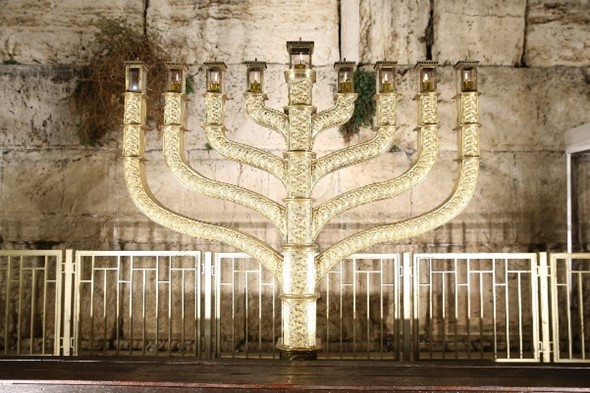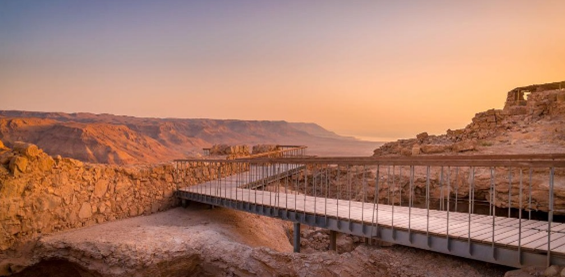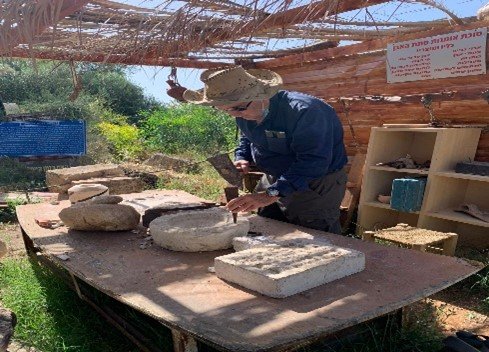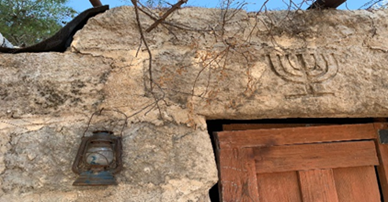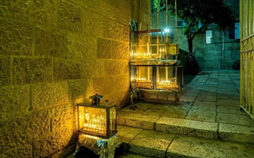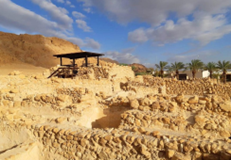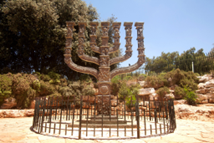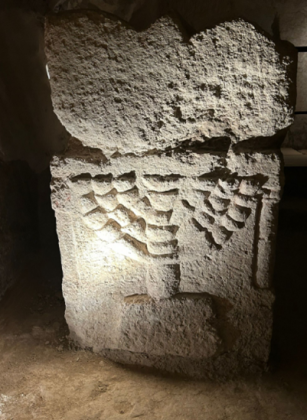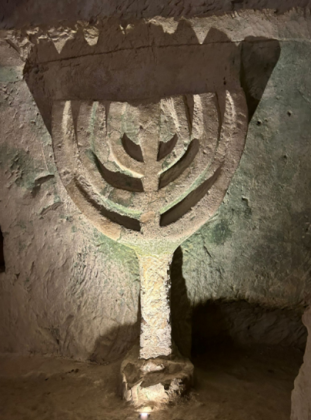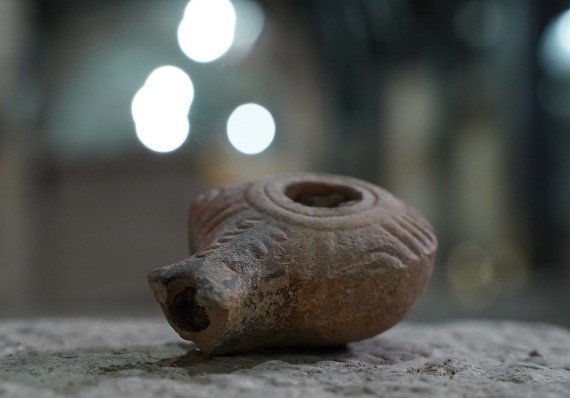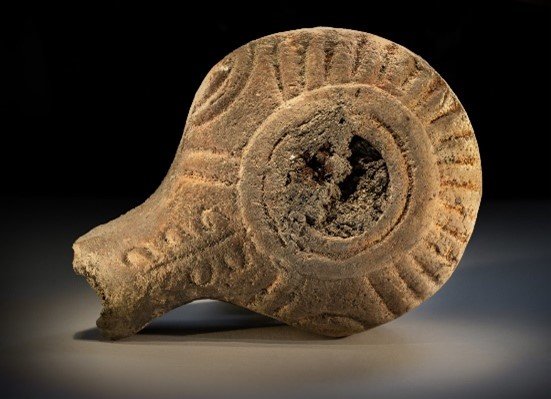Eight Nights and Eight Sites Radiating Light and Hope.
Hanukkah, the eight-day Jewish festival of lights which falls this year between December 7-15, symbolizes light and hope precisely at a time when the days are long and cold. This year, the holiday comes at a particularly dark and difficult time in Israel’s history, as it fights the terror army of Hamas following the brutal and barbaric terror attack on the Gaza periphery communities on October 7 in which more than 1,200 were slaughtered and 240 taken hostage.
Hanukkah, which commemorates the rededication of the Holy Temple, is celebrated with a nightly lighting of the menorah, often in a public space. On the first night, just one candle is lit, with additional candles lit each night until the final night of Hanukkah when all eight candles are lit, in addition to the central candle.
In the second century BCE and against all odds, a small band of Jews, led by Judah the Maccabee, defeated the ruling Syrian-Greek army, drove them from the land, reclaimed and rededicated the Holy Temple in Jerusalem. When they sought to light the Temple’s menorah (a seven-branched candelabra), they found only a single cruse of olive oil that had escaped contamination by the Greeks. Miraculously, the one-day supply of oil lasted for eight days, and these are the events and miracles that are celebrated to this day.
Since the Hanukkah miracle involved oil, it is customary to eat foods fried in oil. This includes the potato latke, an Eastern-European pancake garnished with applesauce or sour cream, and doughnuts, which range from the classic jelly-filled sufganya to gourmet, alcohol-laced fillings.
Hanukkah is also holiday time for Israel’s schoolchildren, and many families take advantage of the short break to tour sites around the country. Here we will take a look at eight sites radiating light, each one related in its own way, to the eight nights of Hanukkah.
First night of Hanukkah
December 7
The Western Wall
The Western Wall or Kotel has always been one of the focal points in Jerusalem for the public celebration of Hanukkah – and this year will be no exception. It is here, in the large plaza, that the traditional bronze, two-meter-high Menorah will be placed. The Hanukkah candles will be lit, according to tradition, using olive oil in special weather-resistant utensils, which ensure that the light of the menorah will shine the entire night.
The official state Hanukkah candle-lighting ceremonies will take place at the Western Wall Plaza every evening of Hanukkah at 16:30, except for Friday 15 December at 15:30 and Saturday, 16 December at 19:30. Among the rabbis, dignitaries and public figures who will participate in the lighting ceremonies will be families who have been displaced from their homes in the north and south, as well as those who have lost loved ones in the fighting and the October 7 massacre.
As Israel grapples with difficult times and so many in Israel and the Diaspora find comfort in prayer at the ancient stones, the lighting ceremony at the Western Wall will offer an island of light and hope.
The events will be broadcast live via the Kotel cameras on the Western Wall Heritage Foundation’s website.
Second Night of Hanukkah
December 8
Sunrise at Masada
One of the most quintessential Israeli experiences, for tourists and locals alike, is to watch the sun slowly rise over the Dead Sea, casting its warm, yellow glow over the surrounding desert. To beat the heat, tourists begin their hike up the famous Snake Path to the top of Masada for this breathtaking sight at the lowest point on earth. Sunrise at Masada has also become the main draw for countless cultural events, from Israeli rock and folk concerts during the Tamar Festival held every fall at the site to major international line-ups such as DJ David Guetta headlining the Dead Sea Rave.
Masada, perched on an isolated cliff in the heart of the Judean desert, stands as a powerful symbol of Jewish resistance against the Roman army during the final days of the Great Rebellion and as a universal representation of the perpetual human struggle between oppression and freedom. It served as the last bastion where Jewish rebels fortified themselves against the Romans, choosing freedom over surrender, even at the cost of their lives.
With remarkably preserved remnants of King Herod’s magnificent fortress-palaces, camps, fortifications, and assault battery, the flat-topped mountain platform towers about 450 meters above the Dead Sea. Masada is understandably one of Israel’s most popular, not-to-be-missed tourist sites, and was designated as a UNESCO World Heritage Site in 2001.
Third night
December 9
Hasmonean Village
The reconstructed Hasmonean village at Shilat, in the center of country near Modi ‘in, is an educational tourism site that has become a popular Hanukkah attraction for both locals and tourists. The site was developed thirty years ago by archeologist Zohar Baram who wanted to recreate a Hasmonean period Jewish settlement in the very region of the country where the Maccabean revolt took place.
During the year, groups and families are encouraged to visit the site with advance reservation. During Hanukkah, special activities will include a guided tour of the site, a display of ancient menorahs and a performance entitled “Matityahu Tells his Story”.
The tour includes the restored Hasmonean house, an ancient synagogue, a natural cave, a winery, olive press, threshing floor and more. Exhibits at the site include reconstructed work tools used during the period of the Maccabees, stoves of various types, wicker baskets, and a demonstration of minting Hasmonean coins.
Visitors will also be able to engage in activities at the site, including harvesting olive trees; crushing olives in the olive press; creating an oil candle from clay; making cloth from the spice plants that grow between the rocks in the restored village; feeding chickens and goats; archery and writing letters using quills.
Fourth Night
December 10
Menorah Tours of the Old City
On Hanukkah, it is customary not merely to celebrate at home the miracle of the oil in the Temple that lasted eight nights – but also to share that light of hope and divine protection with the entire community. As a result, giant-size menorahs can often be seen in cities in Israel and around the world, with public lightings every night.
Jerusalem in general, and the Old City in particular, is renowned for the hundreds of oil menorahs which shine brightly in the ancient, cobbled alleyways, outside private homes. Doughnuts, the customary Hanukkah treat, are handed out to passers-by and the festival songs can be heard in the streets.
It is highly recommended to enjoy this unique experience by wandering individually or in organized tours around the streets and alleyways of neighborhoods such as Nachlaot, Mea Shearim and the Old City at nightfall, when the oil wicks and candles are lit and the blessings and festival songs recited. These outdoor menorahs are encased in glass to protect the flames from the elements, casting a beautiful light throughout the neighborhood.
Fifth Night
December 11
Qumran
Unearthed at Qumran National Park overlooking the Dead Sea, ancient scrolls have unveiled an apocalyptic prophecy foretelling the War of the Sons of Light Against the Sons of Darkness. This battle echoes the historic struggle commemorated during Hanukkah, the Festival of Lights, symbolizing the timeless triumph of light over darkness. As we navigate through challenging times, the echoes of this ancient battle provide inspiration and resilience, offering hope and light for brighter days ahead.
Qumran, an archaeological site with the remains of a settlement dated to 150 BC that lies adjacent to the Qumran Caves, is very popular with tourists and pilgrims. Here the so-called Dead Sea Scrolls were discovered in 1946 by a young Bedouin who stumbled upon a cave containing a clay pot with handwritten manuscripts. A total of 929 manuscripts were subsequently discovered and are now exhibited in a dedicated building in the Israel Museum in Jerusalem.
Qumran is linked to the dwelling place of the Judean Desert sect, commonly believed to be the Essene sect frequently mentioned in the writings of Josephus, Philo, and Pliny the Elder. The scrolls offer insights into the daily lives and beliefs of this enigmatic group, estimated to comprise around 200 men who adhered to a strict routine.
Sixth Night
December 12
The Knesset Menorah
At the new entrance gateway to the Knesset, Israel’s Parliament, stands a five-meter-tall, four-ton bronze Menorah sculpture that resembles the seven-branched candelabra of the Temple. A symbol of light and hope throughout periods of dark history, the Menorah reflects the long and arduous journey of the Jewish people to its homeland.
Crafted by Benno Elkan, a Jewish-British artist of German origin, and gifted to the State of Israel in 1956, the Menorah serves as a visual “textbook” of Jewish history, including about twenty-nine relief engravings of biblical figures and events from the tradition and history of the Jewish people spanning thousands of years. The engravings connect the past, present and future. The six side branches of the Menorah portray the fate of the Jewish people since it was exiled from its land, and the engravings on the center branch portray the people’s fate since the beginning of the return to the land up to the establishment of the State of Israel. The sculpture carries the passage from Zechariah 4:6: “Not by might and not by power, but by my Spirit, says the Lord of Hosts.”
The selection of the menorah as the symbol for the State of Israel was rooted in the state emblem determined by the first Knesset—an emblem featuring a seven-branched lamp. The Knesset Menorah mirrors the menorah depicted in the state emblem, itself a replica of the menorah featured in relief at the Titus Gate in Rome. The relief on the gate portrays captives from the Kingdom of Judah carrying the Temple’s treasures to Rome after its destruction in 70 AD, including the menorah. This depiction, dating back to 79 AD, is considered a faithful representation of the Menorah of the Temple, as it is believed that the artist who created the relief had witnessed the Menorah with their own eyes. Thus, the Knesset Menorah stands not only as a symbol of artistic brilliance but also as a profound representation of the enduring history and resilience of the Jewish people.
Seventh Night
December 13
The Menorah Caves at Beit Shearim
The Menorah Caves at Beit Shearim, a national park in the Jezreel Valley in the Lower Galilee, showcase carvings of the seven-branched candelabrum — a potent symbol of Jewish identity. Nestled amidst the remnants of a Roman city and ancient Jewish burial catacombs, Beit Shearim preserves a rich historical tapestry that resonates with the enduring light of the Hanukkah Menorah.
The park is the final resting place of many prominent Jewish figures, including Rabbi Yehuda HaNassi known for his monumental work in editing the Mishna in the second century, and as such, offers a unique window into ancient Jewish burial customs, art and inscriptions.
Eighth Night
December 14
City of David
The City of David National Park, one of the most prominent and important heritage sites in the State of Israel and in the world, is the place where Jerusalem began its existence as a city. Here King David united his kingdom 3000 years ago, and in this place many parts of the chapters of the Bible were written.
In recent decades, many archaeological excavations by delegations from Israel and around the world have been conducted at the City of David. These excavations have unearthed amazing discoveries – including an oil candle from the Hasmonean period that was discovered in its entirety!
The candle was discovered on the Pilgrim’s Route that is still being excavated. This is the main route that pilgrims would walk from the time of the Second Temple. During this period, candles of this type were used for a variety of uses, from everyday use for building and street lighting, to religious and ceremonial use for Shabbat and Hanukkah candles.
About Israel:
Whether road trips, city trips, swimming, wellness, active and cultural trips, rental car tours or family vacations, the Israeli State Tourist Office provides information about the various regions, cities, and sights in the Holy Land. Located in the eastern Mediterranean, Israel is no more than a seven-hour flight from India. The country offers a sunny climate, a wide variety of historical, archaeological, and religious sites, including houses of several UNESCO World Heritage sites across the country, displaying an intriguing contrast between the ancient and modern periods.


